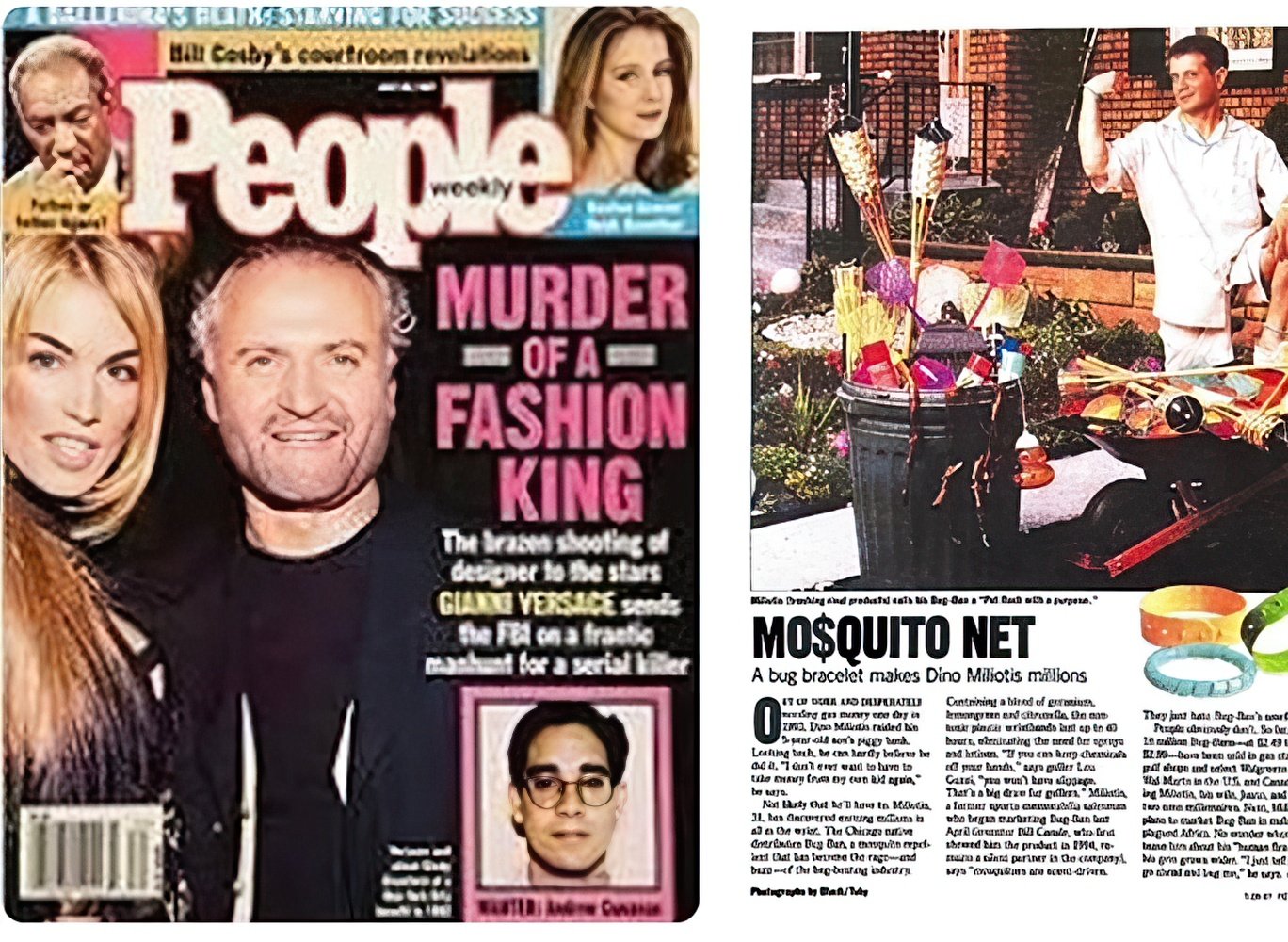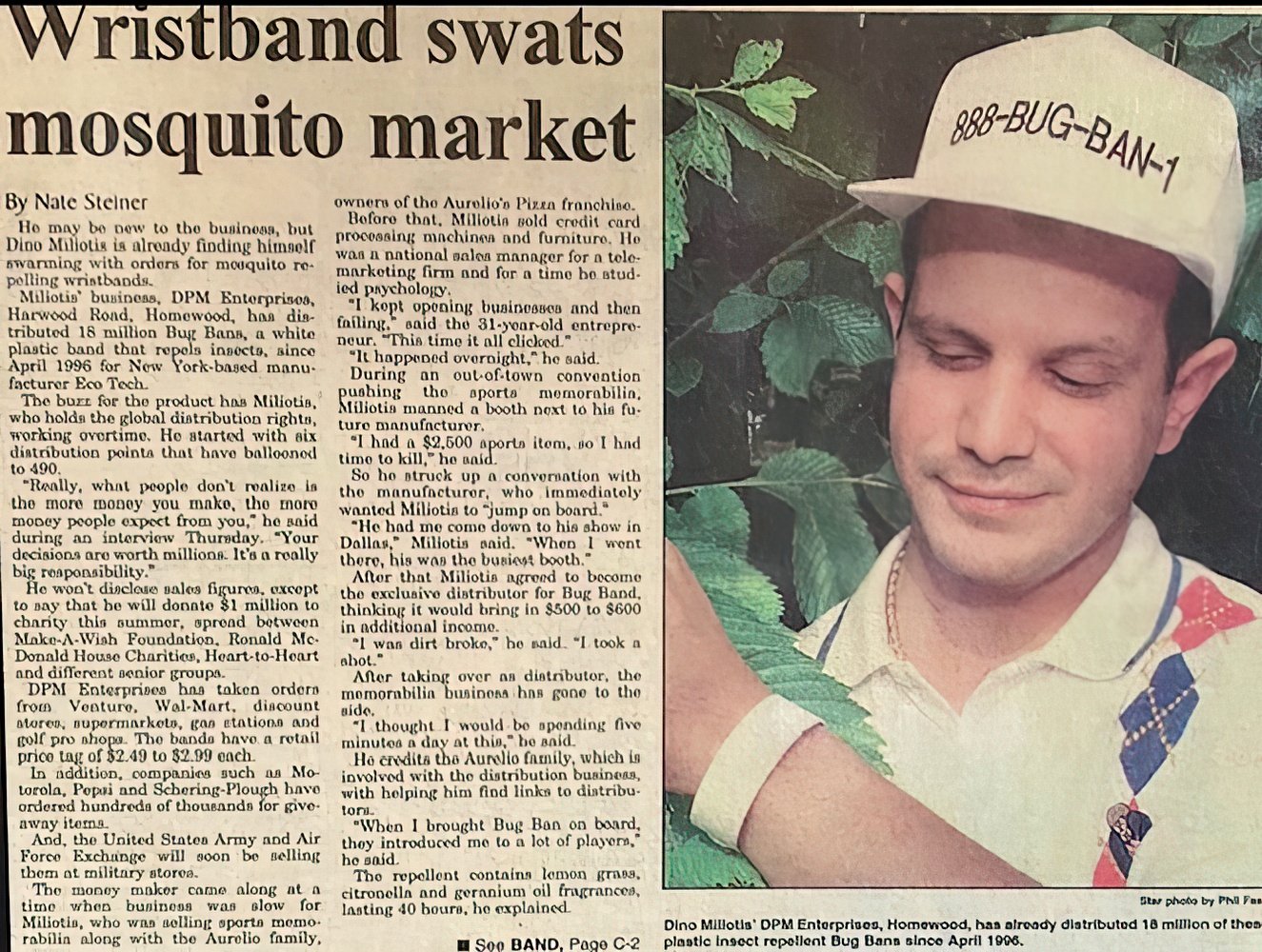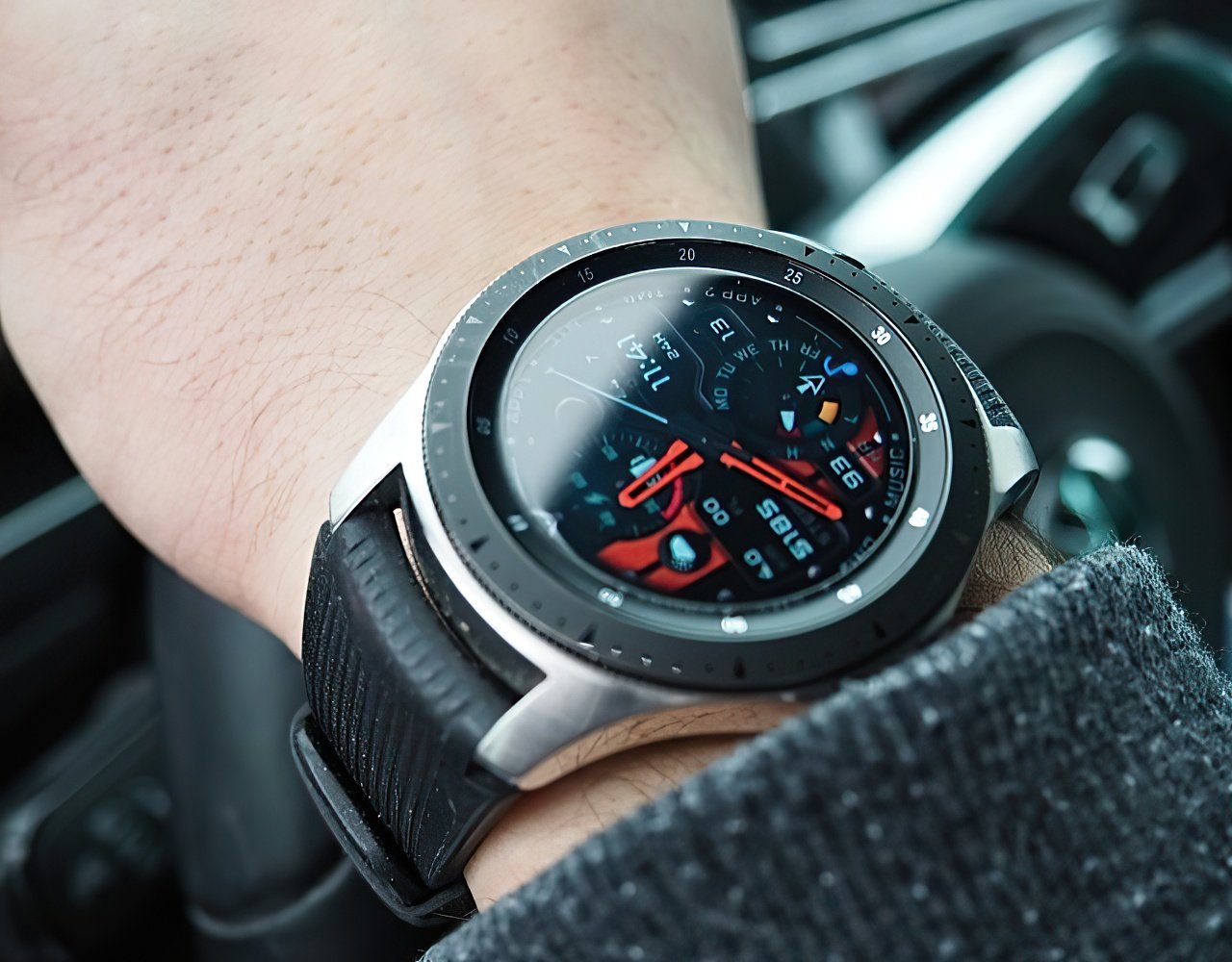On July 7, 2020, I decided enough was enough, and checked myself into rehab.
Dino Miliotis, OpiAID spokesman, with the OpiAID wearable wrist monitoring system.
Instagram: @therealdinomiliotis
Website: OpiAID
“My sobriety started when I finally embraced recovery as a lifestyle” —Dino Miliotis
No one really sees the gradual progression of addiction until it’s too late, yet we all know how we started.
It’s that first sip of vodka, a shot, or that first line of cocaine—the euphoria we felt, and that feeling, however short-lived, of immortality. We take a mental snapshot of that moment, and whether we realize it or not, spend the remaining days of our addiction chasing that feeling; a feeling we can never truly duplicate.
I remember when drugs and alcohol first took over my life; it was July 28, 1997. That was the date of my photo shoot for People Magazine.
People Weekly (Gianni Versace...Murder Of A Fashion King , Cindy Crawford, July 28 , 1997)
“Are you ready kid” said the camera man, “you’re going to be famous.”
I remember trying to respond with something clever, but all I could think of was ‘I know.’ The one thing racing through my mind was the fact I was going to be in the issue forever remembered as ‘the one about Versace’s murder.’
I remember this photo shoot as if it were yesterday. I was young and naive, nervous and overwhelmed. At the time, I believed it was the defining moment of my life.
With fame and fortune, came an incredible amount of responsibility and pressure. Not really ready for ‘prime time’ or media attention, I started my slow and steady spiral into my addiction, seeking solace in a bottle of vodka that I considered my friend.
Dino Millotis' DPM Enterprise, Homewood, has already distributed 18 million of these Plastic Insect Repellent Bug Bans since April 1996.
Over the next two decades, as friend turned to enemy, I lived a rollercoaster of a life filled with conflicting emotions. Outwardly, I enjoyed an immensely rewarding entrepreneurial journey where I was celebrated for my accomplishments in the pages of Crain’s, Entrepreneur and Forbes magazine. I even sat down with Oprah to talk about my rags-to-riches story. Behind the scenes, I was a mess, trying to fill a void in my soul that could never be satisfied.
It was very common, towards the latter years of my addiction, for me to spend hours ‘balancing’ using drugs and alcohol, just to be able to make a brief appearance at the office.
“It’s just the price I pay for the life I choose” I would tell those closest to me. I laugh about that statement now. As I mentioned before, no one really sees the gradual progression of addiction until it’s too late.
On July 7, 2020, I decided enough was enough, and checked myself into rehab. I wanted to change my life. I swore it would be the first and last time I’d walk into a place like this, so I was committed to do whatever it takes.
It turns out I kept the promise I made to myself, never to return to rehab, but my recovery journey started when I ventured back into the real world. And let’s just say, it wasn’t a pretty picture.
“Look to the people standing to your left and those to your right” my recovery counselor said as I was coining out with my group in rehab.
“Most of these people will relapse, overdose or die before the year is over.”
The counselor’s statement terrified me. Pardon the pun, but it was a sobering reminder of just how powerful our disease really is. Still, I was committed. ‘I’ll be the one that makes it,’ I thought to myself, and walked out of rehab to start my journey.
Unfortunately, my recovery journey started in the middle of a Covid lockdown; a time where the whole world stopped turning and when isolation was not only encouraged, but mandated in most parts.
It’s one thing to be isolated with a significant other, a friend or loved-one. It’s quite another to be completely alone in isolation. I didn’t have anyone— I managed to lose every friend or loved-one during the height of my addiction.
If you ever felt guilty about ‘binging’ your favorite TV shows, no worries, the Covid lockdown afforded all of us the freedom to do just that. I personally watched all 456 episodes of ‘Law & Order’; I should have an honorary law degree by now!
But binging my favorite shows soon became boring. Isolation kicked in, and I was left with my old demons, and feeling of using drugs and alcohol to cope.
During that time, I was undergoing MAT (Medically Assisted Treatment). MAT is a combination of behavioral health, counseling and prescription medication, the ‘gold standard for recovery’ they say—protocol to treat people like me, our industry has followed the last 40 years. Speaking only from my personal experience, MAT fell short of a ‘gold standard’ in care. For me, it was mechanical, impersonal and a one-size-fits all bandaid offering no real cure.
“What are you feeling right now” the counselor would ask me.
“I don’t know” I’d reply.
“Can you pick a face on the chart that best describes your anxiety?”
“I’m not sure” I’d respond.
“Are you having thoughts of harming yourself or others right now?”
“Huh?!! What are you talking about?” I’d shout back. “I just want a drink. I want drugs— why am I still feeling this way?”
“Well, honesty you shouldn’t be feeling this way” the counselor remarked. “I mean technically, drugs and alcohol have been out of your system for many months.. almost a year!”
It was so frustrating for me to articulate exactly how I felt, and equally frustrating to hear the counselor tell me how I was supposed to be feeling.
“I’m going to prescribe you additional medication to take care of your baseline anxiety” the counselor said. “But, it takes a while to get into your system, maybe a couple months.”
I couldn’t believe what I was hearing! I felt like I just described wanting to jump off a bridge and was told to wait until they could build me a soft landing. Are you serious?
“I’m also going to give you some meds to handle some depression” the counselor added. “And another prescription for you to take, but only if you really need it—it’s addictive, so don’t use it unless you really need it.”
My head was spinning!
“So let’s try those meds and we can follow up, let’s say, in 2 months—and we’ll see how you’re doing, ok?”
‘It’s no wonder people relapse’ I thought. ‘We don’t stand a chance.’
Before long, I was taking 8 different medications daily, and had amounted to nothing more than a junkie. A different kind of junkie—A pill popper of legally prescribed substances, a walking, lifeless, zombie. Sure, I was still ‘clean and sober,’ but to what end? I didn’t want to socialize, didn’t want to watch television, didn’t want to get out of bed, much less shower—in short, didn’t even care if I lived or died.
‘Is this as good as it gets?!!’ I thought. ‘No way! I’d rather go back to drinking and using!’
Before long, I threw my pills away, and decided to do the unthinkable—go to a liquor store and buy a bottle of vodka. I desperately searched for a reason not to take that first gulp, a sign, anything. Feeling hopeless and sobbing, I decided to pray—something I had not done in years.
“I’m ready, please, just show me what I’m supposed to do” I cried. “Help me!’
All of a sudden, ‘Ding, ding’— the sound of a text message on my cell phone.
It read—‘Hi Dino, this is car wash kid. You probably don’t remember me, but you used to bring your Rolls into the car wash I worked at. Anyway, I don’t know where you are these days, or what you’re doing, but wanted to thank you for sharing your success principles with me. I’m working a real job now, at an office (lol) and because of what you taught me, I got promoted.’
Believe what you want to believe, but I call that a sign—actually, I call it divine intervention. I could have easily been a statistic, just a number that perfectly fit the current recovery narrative—the kind of statistic my counselors rattled off to you in rehab and scared the crap out of you. Instead, I became inspired.
‘I’ve been inspiring people all my life’ I thought. ‘I’ve still got it, and I have something to say!’
And just like that, I started writing my story. Eight months of writing, 12-15 hour days. It was just what the doctor ordered. It was amazing—no cravings, no anxiety, no depression. Instead, all of that was replaced by this incredible drive;
the kind of drive I once had, a long time ago.
When my book was published, the most amazing thing happened. This thing called the ‘recovery community’ came out in support of my freshly minted memoir. Up until that time, I didn’t even know such recovery platforms existed. Of course not, I had my head buried in the sand and into my own thing for so many years, how would I?
The recovery community was a wonderful thing! I immediately fell in love with that community. I started chatting with people morning, noon and night—I mean, recovery is not a 9-5 thing. I’d be up at all hours working with others, telling my story, offering hope, trying to inspire them.
The administrators of recovery platforms took notice. I became such a permanent fixture online that it was not uncommon for admins to list me as the contact guy for others who needed help, if they were unavailable or on vacation. I was honored at the gesture and the trust.
As the months passed I started to get invited to join podcasts. My popularity on podcasts lead to speaking engagements—I was traveling coast-to-coast. And then one day, a chance meeting puts me front-and-center for the adventure of a lifetime—OpiAID.
It was as if somehow, I was training all my life for the marathon I was about to run. Everything made sense again, and I had immense focus and purpose. Best of all, it was a fresh start to give hope to millions around the world who were just like me—addicts.
But OpiAID didn’t call us addicts. Instead, they refer to us as ‘neighbors’. People who suffer from a terrible disease. People who need our help. People who are searching for a recovery tool, a better way, hope—because recovery is all about hope.
They had me at “hello.”
On February 20, 2024 I held a press conference.
Here’s my story:
________________________________________
OpiAID’s AI-enabled wearable technology
Tech Collaboration is Harnessing the Power of AI to Combat the Opioid Epidemic
Pictured: OpiAID's state-of-the-art, AI-enabled wearable technology.
CHICAGO , ILLINOIS -- “Today, we are pleased to announce a groundbreaking collaboration between artificial intelligence (AI) technology and Medically Assisted Treatment (MAT) programs, poised to revolutionize addiction care, and I’m thrilled to be a part of it,” says Dino Miliotis, renowned entrepreneur, speaker, and now, spokesperson for NC-based data science company, OpiAID.
Miliotis, a Chicago native, is best known as the inventor of an all-natural insect repelling bracelet, Bug-Ban. Nearly three decades ago, he got his break showcasing his invention and marketing savvy on the Oprah Winfrey Show.
“I’ll never forget that day,” says Miliotis. “The exposure completely changed my life, and I’m forever grateful.”
But fame and fortune came at a price, and Miliotis fell into a downward spiral of addiction. As a recovering addict, Miliotis documents his life journey and road to recovery, from a more than 20-year battle with alcohol and substance use, in his memoir, ‘There Is No Box.’ Since his recovery, Miliotis has traveled the country helping to inspire thousands struggling with addiction.
“As much as I’ve tried to help, there’s still a record number of people beyond my reach, especially those affected by fentanyl” says Miliotis. “Behind the faces were stories of pain, loss, and shattered lives. Opioid abuse not only affects the individual struggling with addiction but also ripples out to their loved ones, healthcare providers, first responders, and communities at large. Families are torn apart, careers are derailed, and futures are extinguished prematurely due to the grip of addiction. It’s truly an epidemic.”
The CDC reported that opioids were involved in nearly 70% of all drug overdose deaths in the United States. Examples of opioids include morphine, codeine, oxycodone, heroin, methadone and fentanyl. Fentanyl is a synthetic opioid that is up to 50 times stronger than heroin and 100 times stronger than morphine.
According to The Health Resources and Services Administration (HRSA) more than 130 people a day die from opioid-related drug overdoses.
“I believe estimates are even higher than that,” says Miliotis. “Some sources put the death toll at one every four minutes! It’s completely unacceptable. We need solutions, not just point at the problem!”
Then in 2023, a chance meeting with OpiAID’s founder, David Reeser, sparked a conversation that soon evolved into a collaboration merging innovative tech solutions with savvy marketing strategies.
“OpiAID’s mission to fight this epidemic aligned so perfectly with mine” says Miliotis. “I just had to be part of it, so I jumped at the chance to get involved.”
North Carolina-based OpiAID, led by its founder, Reeser, is a data science company that has been working on making addiction treatment safer and more effective, offering decision support technology to clinicians in Medically Assisted Treatment (MAT) also referred to as Medication for Opioid Use Disorder (MOUD), leading to better clinical outcomes.
MAT has long been recognized as a cornerstone of effective opioid addiction treatment, combining medications with counseling and behavioral therapies to address the complex nature of substance use disorder. Now, AI-powered tools are enhancing the efficacy and accessibility of MAT, empowering healthcare providers and patients alike.
Using OpiAID’s sophisticated algorithms and predictive analytics, AI algorithms analyze vast amounts of data to personalize treatment plans, and predict patient outcomes with unprecedented accuracy.
“By leveraging real-time patient data and continuously learning from treatment outcomes, the AI enables healthcare providers to tailor MAT [MOUD] interventions to the unique needs of each individual, maximizing effectiveness and minimizing risks” says Reeser.
The company’s AI-driven decision support platform is also helping to expand access to MAT in underserved communities, breaking down barriers to care and reaching those who might otherwise struggle to access treatment. By partnering with other healthcare providers who deliver virtual consultations, monitor patient progress remotely, and provide ongoing support, OpiAID believes this platform collaboration will transform the delivery of addiction care in the digital age.
In addition, the company has created an application that runs with wearable devices. Reeser believes utilizing wearable devices will be “a gamechanger.”
Studies suggest that a significant portion of people struggling with substance dependence may not seek treatment due to various reasons, including stigma, denial, fear of legal consequences, or lack of awareness about available resources. These findings suggest that a wearable device would expand both reach and depth of care.
“The ultimate goal is to provide timely and actionable data that will allow for just-in-time interventions that could save lives” says Reeser.
“For me, OpiAID’s tech application is endless“ says Miliotis. “But like all things technical, it must be relatable and easily understood by ordinary people, just like me. That’s where I believe I can help raise awareness.”
“Who better to promote our mission, or the use of a wearable smart device, than the person [Miliotis] who invented the ‘bracelet’ [Bug-Ban],” says Reeser. “He literally promoted the use of wearables to millions around the world almost 30 years ago, which, if you think about it, is such forward thinking—That’s exactly the type of person we want to collaborate with.”
End of press release
________________________________________
In closing, to those in recovery, I’ll say this; recovery is a lifestyle, not just a sober moment. When you finally embrace that, you can move forward.
Where I initially thought that my life was over, it was actually just the beginning. Where I initially thought that being in recovery would hurt my career, it actually helped it. My struggles have become my strength—and I’m here to tell you, you’re stronger than you think.
Buckle up, my neighbors in recovery, and enjoy the ride!
“It matters less where you’ve been and more about where you’re going”—Dino Miliotis.
If you, or a loved one suffer in addiction, please reach out. We have resources that can help.




